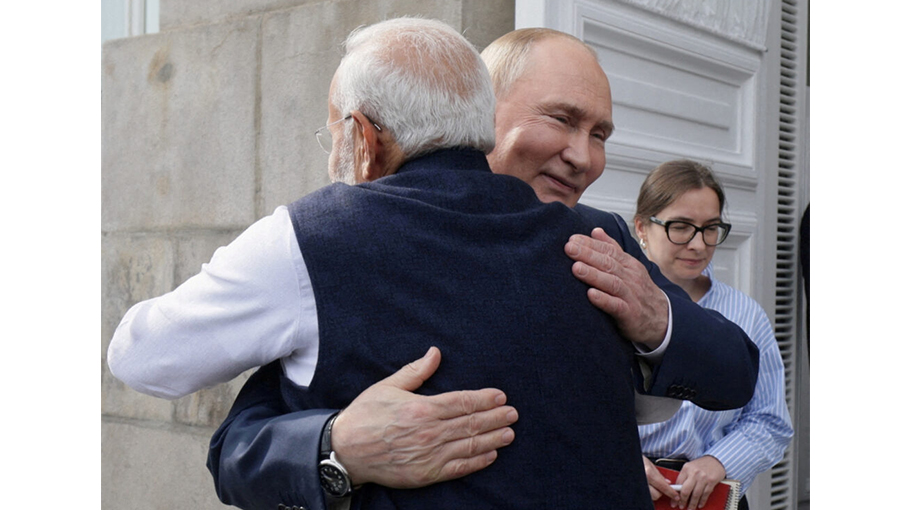India picks its friends as it treads between Russia and the West

Amit Ranjan
Indian Prime Minister Narendra Modi’s bear hug with Russian President Vladimir Putin during the 22nd India–Russia Annual Summit in July 2024 irked the US administration and many other Western capitals. Even Beijing was uncomfortable with the photo. As a leader of the ‘liberal’ global order and ‘advocate of law and morality’ in international relations, the Western world, led by the United States, imposed sanctions on Russia after its invasion of Ukraine in 2022. India, as a ‘close’ friend of the United States and a member of the Quad, was expected by many to follow the Western world’s line.
But following the principles of ‘freedom of choice’ and ‘strategic autonomy’ in its foreign policy, India took a different stance on the invasion. New Delhi called for a peaceful and amicable solution to the war without disturbing its ties with Moscow. One of the prime reasons for India’s engagement with Russia is oil. India–Russia trade volume in 2023 was US$57 billion, which the two countries agreed to increase to US$100 billion by 2030. India is the largest client of Russia’s seaborne oil and its second-biggest importer, just behind China, which has also benefited from the discounted prices.
In the 2023–2024 financial year, Russian crude oil made up about 36 per cent of India’s total oil imports, accounting for around 232.31 million tonnes or 1.70 billion barrels. It is estimated that between April 2022 and May 2024 Indian oil companies have saved more than US$10.5 billion by purchasing crude oil from Russia at a discounted rate. Importing oil from Russia has also enabled India to cut imports from the Middle East and from Asian countries, where prices tightened following Saudi Arabia’s additional supply cuts in July 2023.
In addition, between 60 and 70 per cent of India’s conventional military hardware is of Soviet or post-Russian origin. Over the last two decades, Russia supplied around 65 per cent of India’s weapons purchases worth more than US$60 billion. During the July summit, the two sides agreed to ‘encourage joint manufacturing in India of spare parts, components, aggregates and other products for maintenance of Russian origin arms and defence equipment under Make-in-India program’. Despite a chequered history and differences of opinion on some important matters concerning New Delhi, Moscow has been a dependable friend of India in past and recent years. India’s Minister of External Affairs, Subrahmanyam Jaishankar, observed that ‘Russia never hurt India’s interests, Moscow–New Delhi relations were always stable’. India’s evolving significance to Russia can be seen through its official documents. In the 2021 revised National Security Strategy and 2023’s foreign policy concept, the significance of ties with both India and China were mentioned together, rather than China first and India later. It has not been easy for India to remain engaged with Moscow during the war in Ukraine. India has had to spend more time convincing the West that it has not diverted from its strategic objective of checking China in the Indo-Pacific region — while ensuring no serious ripples affect its ties with Moscow. The Russian invasion also affected Indian citizens. When the war started in 2022, thousands of Indian students left their studies in Ukraine to return to India. Meanwhile, some Indian citizens are serving in the Russian army. On 9 August 2024, Jaishankar told the lower house of the Indian parliament that of the 91 Indian nationals recruited into the Russian army, eight have died, 14 have either been discharged or repatriated, and 69 still await release from the Russian army.
India has not yet endorsed statements highly critical of Russia. In 2023, a Quad statement expressed ‘deep concern’ over the war in Ukraine and its ‘serious impacts’ on the global economic system and supply chains, without criticising Russia directly. At the G20 summit in New Delhi in September 2023, the official declaration stated ‘all states must refrain from the threat or use of force to seek territorial acquisition against the territorial integrity and sovereignty or political independence of any state. The use or threat of use of nuclear weapons is inadmissible’. Ukraine, not present at the summit, was unhappy with the wording. But the United States, United Kingdom, Russia and China praised the outcome.
In June 2024, India refused to endorse a statement signed by over 80 countries at a peace summit in Switzerland calling for the protection of Ukraine’s ‘territorial integrity’. India maintained that peace is possible only if the proposal is amicably accepted by both Ukraine and Russia. In July, after meetings of the foreign ministers in Tokyo, the Quad issued a joint statement expressing ‘deepest concern’ over the Ukraine invasion and reiterating that ‘all states must refrain from the threat of or use of force against the territorial integrity and sovereignty or political independence of any state’. India’s position on Russia stems from material interests and is guided by the principles of autonomous foreign policy and the freedom to choose its friends.
In the first visit by an Indian prime minister since India and Ukraine established diplomatic ties in 1992, Narendra Modi will land in Kyiv on 23 August. Ukrainian President Volodymyr Zelensky was disappointed with the Modi–Putin meeting, terming it ‘a devastating blow to peace efforts’ and describing the hug as ‘the leader of the world’s largest democracy embracing the bloodiest criminal in the world’.
Modi’s visit will certainly address Kyiv’s grievances against India. The Modi–Zelensky meeting will be a balancing act that may silence many Western critics of India’s policy towards Russia and Ukraine. But one will have to watch Moscow’s reaction to the visit.
Amit Ranjan is Research Fellow at the Institute of South Asian Studies, National University of Singapore
Source: East Asia Forum




